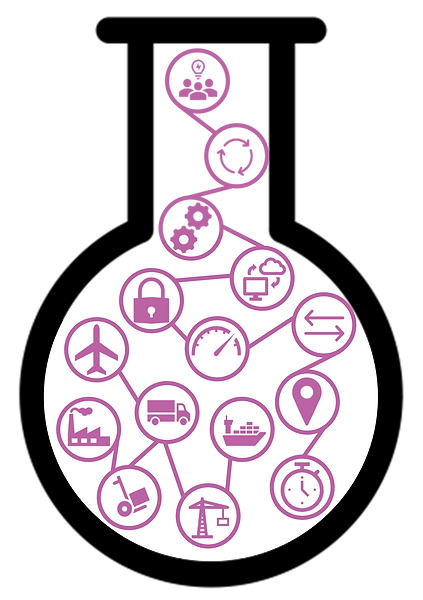8 ideas to keep your Supply Chain moving in a crisis like the COVID-19
- Gloria Isamar Rivera
- Apr 10, 2020
- 5 min read
Updated: Jul 24, 2020
020 is bringing many challenges to society. COVID-19 is the new pandemic.
Businesses are operating remotely, many others have closed leaving thousands of professionals unemployed!
It's like the tip of an iceberg. The popular "domino effect" is right in front of us all.
This is where our new normal begins.
Economics, commerce, work, education, health, transportation, communication, to name a few, are starting to feel the impact of #COVID19.
Our usual ways are being transformed to be able to respond to different situations in life.
As human beings, we are able to successfully adapt to changes to survive. This time, every-single-thing in life as we know it, is changing.
It's time to act in a smart way.
After a little research, I've come up with the following ideas to help to keep the flow of goods moving in your supply chain.
1. Safety comes first, please
Consider safety as a priority. Always. No questions asked. If safety is being compromised, nothing good will come out of it. It is not negotiable to put at risk your human assets. If the government is recommending social distancing, offer your staff to help them set up an office space in their homes. Set up a remote schedule, meetings, video calls. Today, technology has provided us with the opportunity of connection, dissipating distances. If your team's job is done with a computer, internet, and a phone, they can work from anywhere! Take advantage of that! And enjoy the process!
2. Team Up
Brainstorming is always a good idea. In a situation like this, diversity is highly appreciated. Work with your team, welcome the creative thinking your people have and recognize their effort. Don't forget a team is a group of internal customers. They are also experiencing uncertainty but are there with you! Talk to them to find areas of opportunity to serve them better. In the end, they are serving your company... If areas of opportunity are not identified early, mayor issues could impact your supply chain. Choose to be a leader that is present in the middle of uncertainty; be a part of your team.
3. Identify your internal / external weaknesses
Every company should know their weaknesses. Keep a close eye on them. Are those weaknesses real? Will those weaknesses affect us now? Revisit them... You may have to adjust the focus to find a positive outcome. Let's say one of your company's weaknesses is its lack of online presence. Well, your company has a huge opportunity NOW to change that weakness into a strength.
4. Analyze all the links in your Supply Chain
Supply chains should maintain a constant flow of goods and information. If you have to change a supplier today, do you have options? I hope the response is: YES! If not, OK... but you need to act fast! List all suppliers in your analysis and look for alternatives. Don't wait for something to go wrong to do the research. If you have only 1 supplier supporting all your demand, your supply chain is at high risk of being disrupted, or even worse, broken. Identify and analyze your suppliers. Establish 2 or 3 alternatives per supplier. Evaluate the capability of each alternative to respond to a request, lead times are extremely important (processing, packaging, releasing & transit). If a local option is available, consider it. Keep an eye on the costs. After having the alternatives with lead times and cost, validate each one with a hypothetical experiment. Do the results are good? Are you feeling confident about the alternatives, times, and costs? Having options before needing them is extremely beneficial.
5. Define your capacity to respond to your customers
Identify your process, establish a timeline, work backward, adjust accordingly, repeat. For example, let's say it takes 3 weeks to process, ship, and deliver your final product and that product is urgently needed in hospitals and clinics today. Now let's think we have only 5 days to work with processing, shipping, and delivery; think today is Monday and the product is needed on Friday at destination; that is our timeline. Then, work backward: transit time, shipping/processing, and raw material handling. Does the process fit in the timeline? Can the transit time be reduced? Is there any other process that can be adjusted? Companies tend to outsource based on competences. In times like the ones we are living now, outsourcing could be a weakness and it should be reviewed. How well, prompt, and assertive your team is able to manage last-minute requests in a crisis, is a treasure. The capacity to respond quickly on short notices -and we must define the range for "quickly" first- could really allocate your company to the top of the list or in the darkest spot of the market.
6. Be realistic, but also compassionate
Adaptability is urgently needed. Things are changing fast. Expect hard times. Be ready to use your best attitude, every day. There are others putting their lives at risk to fight against the COVID-19. If you are working from home, enjoy it! Have a good time when talking to your peers. They are also living in uncertainty at home. Value their opinion, their feelings, and their work. Help in any way you can. Don't wait for things to get done, make them happen.
The COVID-19 is setting a new standard in all aspects. Looking into the future, I suggest using this experience as a learning step to improve yourself and the way you will manage your supply chain now and moving forward.
7. Elevate your strategies
When planning for the future, include bad scenarios and catastrophic events in your business plans and how your company will respond to them. Use this experience as a lesson. If you can imagine something bad could happen, it can happen... If you don't have a plan, you won't have the clarity to create an effective strategy in the middle of chaos. Why? Because you will be focused on surviving the chaos, not on how to respond in a smart way to it. Don't try to predict the future. Instead, think ahead, imagine, and plan to be ready to act. It is always better to be prepared. It will provide you, your team, and your company a starting point.
8. Remember the challenges
When closing new contracts, remember the challenges you encountered with COVID-19. Work with vendors, suppliers, and shippers. Go over your business plan and strategies, adjust them to the future. Meet with your team, establish remote work policies, and be ready to receive their feedback.
In this industry, an out-of-the-box thinking approach is always needed. We, as Supply-Chainers and Logisticians, are more than prepared to accept challenges and work toward a positive outcome.
This situation is shaping a new way of reasoning. There is no room for errors.
Make every one of your moves count!
*If you think I can help your company in any way, please let me know!
Send me an email with more details: MyLogisticsLab@gmail.com.
About the Author: My name is Gloria Isamar Rivera. I have more than 17 years of combined experience in business administration, marketing, customer service, supply chain, logistics, and 3PLs. I consider myself a young professional, a supply chain leader, and an out-of-the-box strategist. I enjoy the simple things in life and value every process as a learning experience. Looking forward to sharing something interesting for you very soon! Thank you for reading! ;-)

















Comments